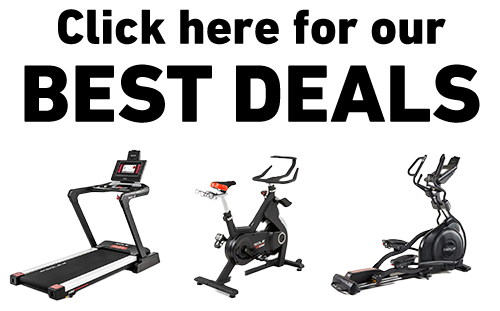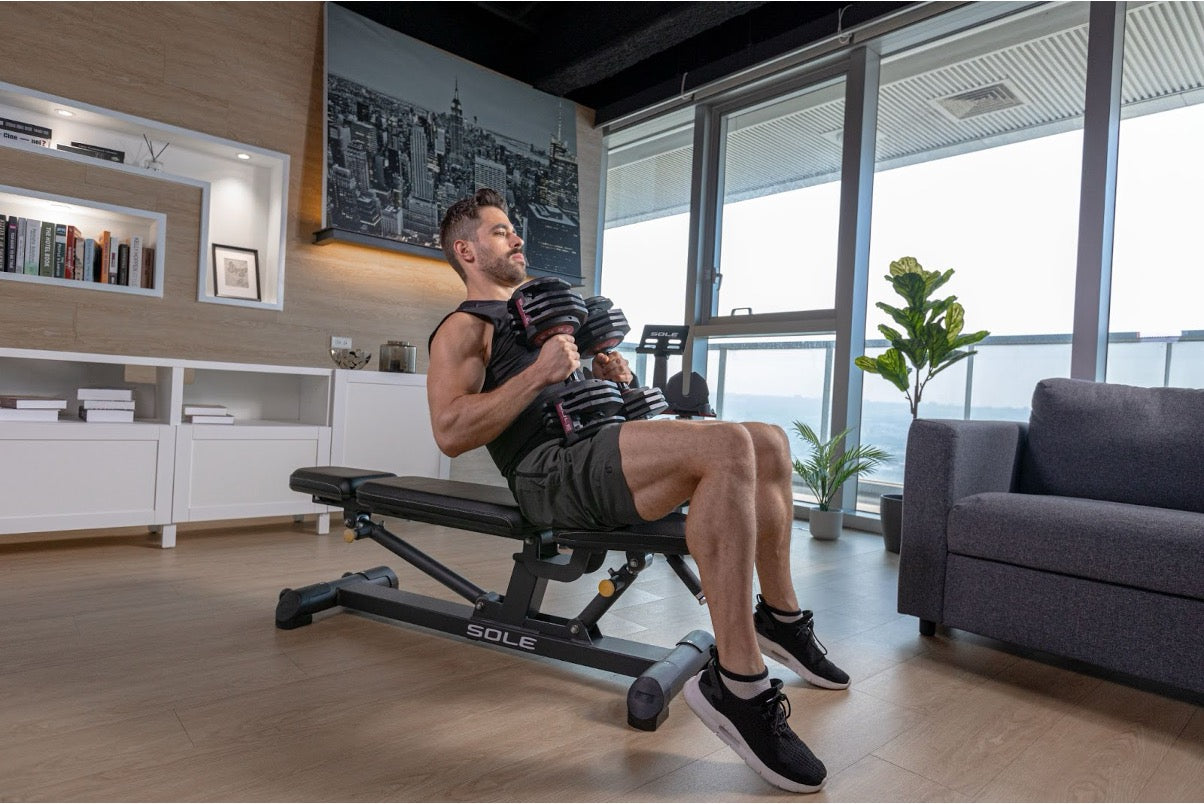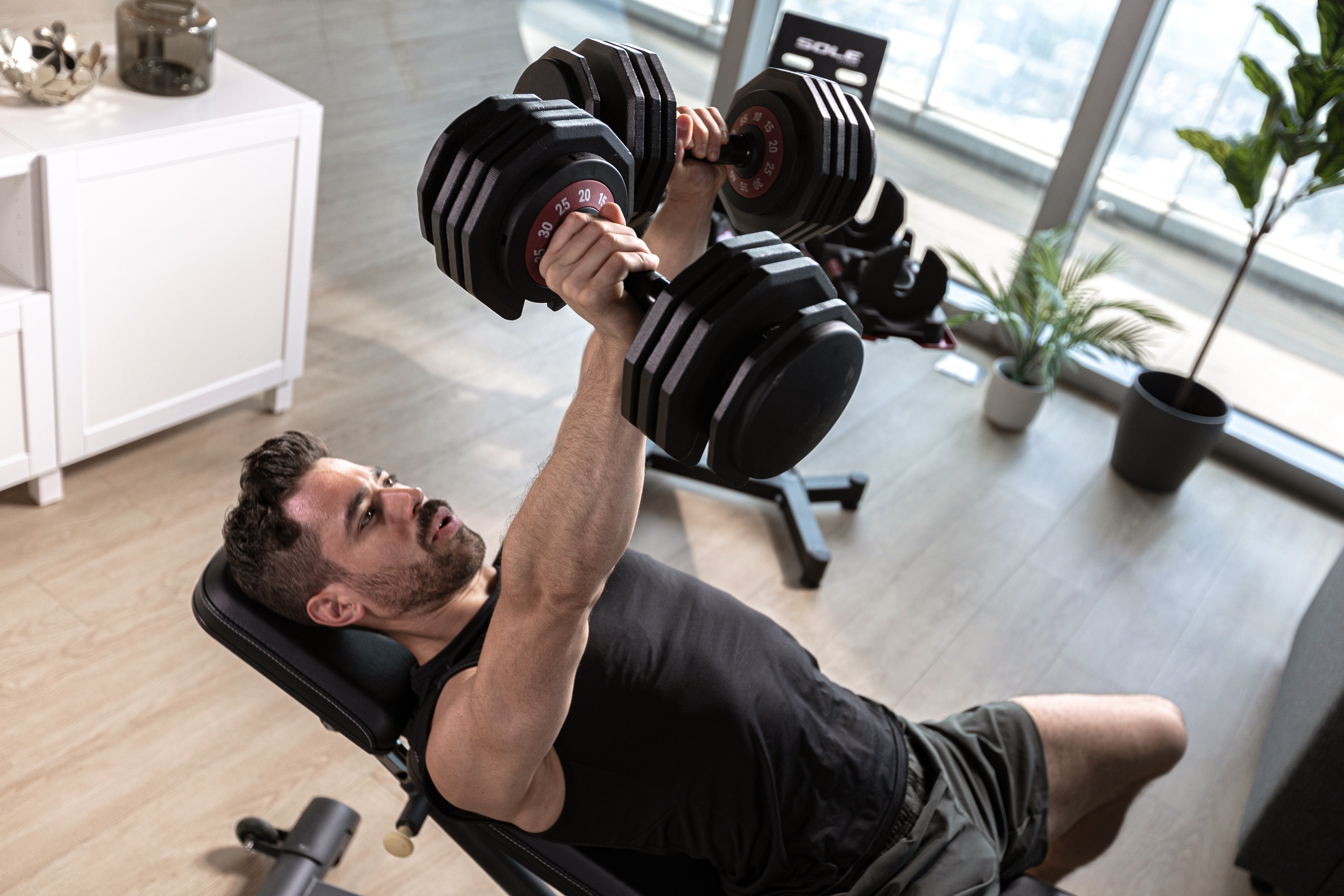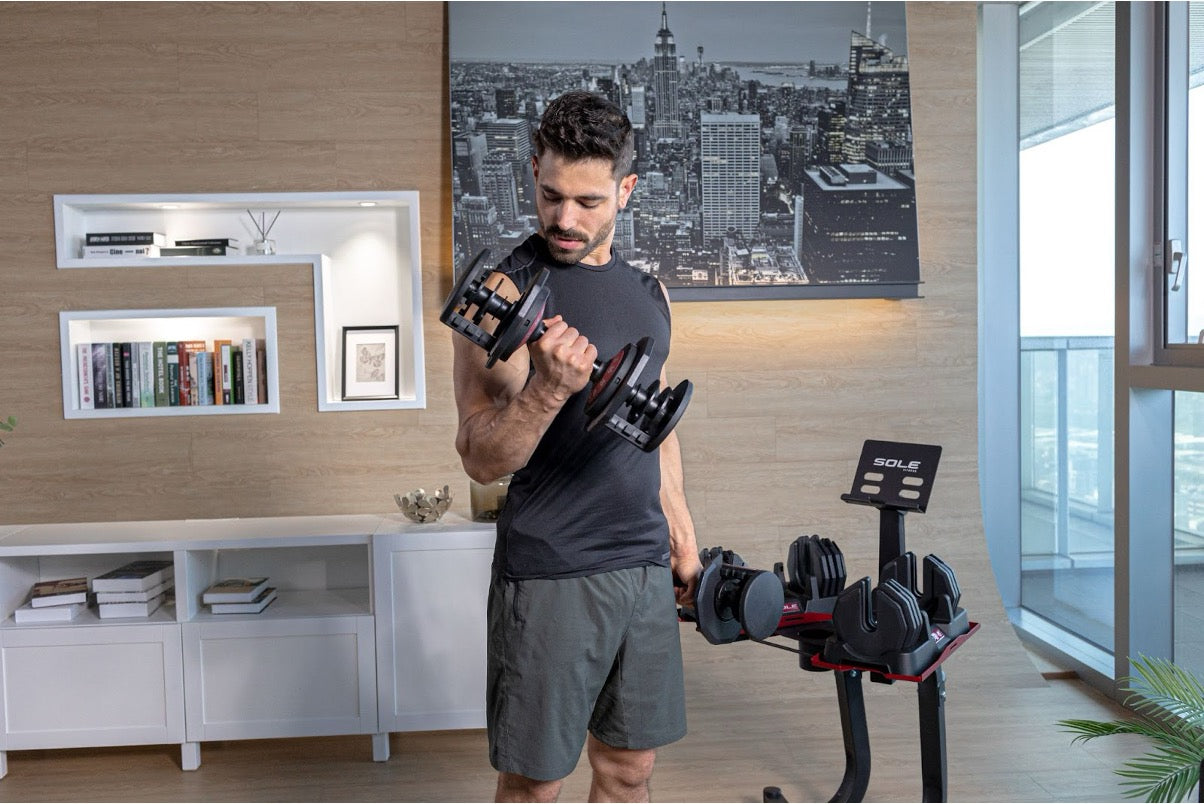Key Takeaways
- The front delts refer to the anterior deltoid muscle in your shoulder that moves your arm forward.
- Some of the best dumbbell exercises to develop front delts are dumbbell shoulder press and Arnold Press.
- Having proper form while doing dumbbell exercises prevents injury and maximizes muscle growth.
- At SOLE, our dumbbells can help you build defined front delts, thanks to powerful features like knurled ergonomic handle design and anti-roll rubber-coated hexagon shape.
Benefits of Dumbbell Exercises for Front Delts
Dumbbells are awesome for hitting your front delts. They let you move through a greater range of motion than machines, which means you’re working more muscle fibers and promoting better growth.
Since each arm works independently, dumbbells also help correct muscle imbalances when one side is stronger than the other.
Using dumbbells forces your body to engage stabilizing muscles, strengthening all those smaller supporting muscles around your shoulder joint.
This leads to healthier shoulders and a lower risk of injury.
|
At SOLE, we're proud to offer top-quality exercise equipment designed for home and gym use. Our machines are built to meet the highest standards of durability and performance, making them ideal for fitness enthusiasts at any level. SOLE Products
|
5 Best Dumbbell Exercises for Defined Front Delts
1. Dumbbell Shoulder Press
The dumbbell shoulder press is pretty much the go-to move for building front delts. It's a compound exercise, which means it hits multiple muscle groups – not just shoulders but triceps and upper chest too.
To perform the Dumbbell Shoulder Press correctly, follow these steps:
- Sit on a bench with back support, holding a dumbbell in each hand at shoulder height, palms facing forward.
- Engage your core and keep your feet flat on the floor.
- Press the dumbbells overhead until your arms are fully extended, keeping your elbows slightly bent.
- Slowly lower the dumbbells back to the starting position, maintaining control throughout the movement.
When performing the Dumbbell Shoulder Press, avoid these common mistakes:
- Arching your back excessively, which can strain your lower back.
- Allowing your elbows to flare out too much, which can lead to shoulder injuries.
- Using momentum to lift the weights, which reduces the effectiveness of the exercise.
2. Dumbbell Front Raise
The dumbbell front raise is an isolation exercise that specifically targets the front delts, making it an excellent addition to any shoulder workout routine.
Here's how to perform the Dumbbell Front Raise with proper form:
- Stand with your feet shoulder-width apart, holding a dumbbell in each hand with your arms at your sides.
- Keep a slight bend in your elbows and lift the dumbbells in front of you to shoulder height.
- Pause briefly at the top, then slowly lower the weights back to the starting position.
To increase the intensity of the Dumbbell Front Raise, consider these variations:
- Perform the exercise seated to eliminate momentum and further isolate the front delts.
- Use a lighter weight and perform higher repetitions for a more endurance-focused workout.
3. Arnold Press
The Arnold Press is an interesting exercise named after the legendary bodybuilder Arnold Schwarzenegger. This movement targets the front delts while also engaging the side delts and triceps (image courtesy of Men’s Health).
Here's how to perform the Arnold Press:
- Grab a pair of dumbbells, one in each hand.
- Sit on a bench with back support or stand with your feet hip-width apart. Keep a slight bend in your knees for stability.
- Hold the dumbbells at shoulder height with your palms facing your body (neutral grip) and elbows close to your torso.
- Tighten your core muscles to maintain stability and avoid arching your lower back.
- Keep your shoulders down and back, and ensure your head and neck are in a neutral position.
- Begin by rotating your wrists outward as you press the dumbbells upward. Your palms should gradually turn from facing you to facing forward during the movement.
- Push the dumbbells overhead in a smooth, controlled motion until your arms are fully extended but not locked out.
- At the top of the press, your arms should be straight with a slight bend in the elbows, and your palms should face forward.
- Maintain distance between the dumbbells to avoid clashing them together.
- Slowly reverse the motion by rotating your wrists inward as you lower the dumbbells back to their starting position at shoulder height.
- Keep control throughout the descent to maximize muscle engagement and avoid injury.
- Perform 8–12 repetitions for 2–3 sets, depending on your fitness level and goals.
Keep these tips in mind to do the Arnold Press safely:
- Start with a good warm-up – do some light cardio and dynamic stretches to get your blood pumping and muscles ready.
- Always go with weights you can actually control throughout the whole movement. Not sure? Start lighter and work your way up as you get more comfortable.
- Good form is key too. Keep your core tight, don't arch your back too much, and make sure your movements are controlled and deliberate.
- Don't rush through your reps just to finish – focus on that mind-muscle connection to really feel the burn in the right places.
- And hey, listen to your body. If something feels off or painful (not the good kind of burn, but actual pain), stop right away and check your form. Better to take a break than push through and end up injured.
4. Lateral Raises for Front Delts
While lateral raises are typically associated with targeting the side delts, they can also be adapted to engage the front delts effectively. This makes them a versatile addition to your shoulder workout routine.
To do lateral raises:
- Stand with your feet shoulder-width apart, knees slightly bent for stability.
- Hold a dumbbell in each hand by your sides, palms facing your body (neutral grip).
- Tighten your core muscles to maintain stability and avoid arching your back.
- Keep your shoulder blades down and back, avoiding any shrugging.
- With a slight bend in your elbows, exhale and slowly lift the dumbbells out to the sides.
- Lead with your elbows, ensuring they rise slightly higher than your hands.
- Lift the dumbbells until your arms are parallel to the ground or slightly below shoulder level.
- Avoid raising them higher than shoulder height to prevent strain on the shoulder joints.
- Hold the position briefly, ensuring maximal muscle engagement in the lateral deltoids.
- Inhale and slowly lower the weights back to the starting position with control.
- Focus on the eccentric (lowering) phase to maximize muscle tension.
- Perform 8–12 repetitions for 2–3 sets, depending on your fitness level and goals.
Some pro tips to keep in mind while doing lateral raises:
- Start with lighter weights and higher repetitions for endurance and muscle activation.
- Gradually increase the weight as you build strength and confidence in the movement.
Here are some of the benefits lateral raises offer:
- They help improve shoulder stability and mobility, which are crucial for overall shoulder health and function.
- They also engage the upper back and trapezius muscles, contributing to better posture and upper body strength.
- You'll be able to enjoy a more balanced shoulder workout that addresses multiple muscle groups. This can lead to improved shoulder aesthetics and performance in other exercises.
- Also, lateral raises can be easily modified to suit different fitness levels. Even if you're a beginner or an advanced lifter, you can adjust the weight and repetitions to match your goals and capabilities.
5. Incline Dumbbell Bench Press
The incline dumbbell bench press is a fantastic exercise that targets the front delts and engages the upper chest and triceps.
Here’s how you can perform the incline dumbbell bench press:
- To set up for the Incline Dumbbell Bench Press, adjust the bench to a 15-45° angle. A lower angle (15–30°) hits your upper chest more, while a higher one (30–45°) shifts the work to your shoulders.
- Make sure that your feet are flat on the ground and your back is firmly supported by the bench.
- Sit on the bench with a dumbbell in each hand, resting them on your thighs. Lean back and use your knees to help lift the dumbbells to shoulder height.
- Lie back on the bench with the dumbbells at shoulder height, palms facing forward. Keep your elbows at a 45-degree angle to your torso and your feet flat on the floor for stability.
- Tighten your core and retract your shoulder blades into the bench to maintain stability and protect your shoulders.
- Exhale and press the dumbbells upward in a controlled motion until your arms are fully extended but not locked out. Keep the dumbbells close together but not touching.
- Inhale and slowly lower the dumbbells back to the starting position, keeping your elbows at a 45-degree angle. Lower until your upper arms are slightly below parallel with the bench.
- Perform 8–12 repetitions for 2–3 sets, depending on your fitness level and goals.
Maximizing Your Front Delt Workouts
Warm-Up Exercises
Before starting your front delt exercises, spend at least 5-10 minutes warming up. This can include light cardio, dynamic stretches, and mobility exercises for the shoulders.
A good warm-up increases blood flow to the muscles, reduces the risk of injury, and prepares your body for the workout ahead.
Rest and Recovery Strategies
Recovery is just as important as the workout itself. Ensure you get enough rest between workouts to allow your muscles to repair and grow. This means taking at least 48 hours between shoulder-focused workouts.
Additionally, prioritize sleep, hydration, and nutrition to support muscle recovery. Consider adding stretches or yoga into your routine to improve flexibility and reduce muscle tension.
Sample Front Delt Workout Routine
Here's a sample workout routine to help you build strong and defined front delts:
Beginner Routine
- Warm-up: 5-10 minutes of light cardio and dynamic stretches.
- Dumbbell Shoulder Press: 3 sets of 10-12 reps.
- Dumbbell Front Raise: 3 sets of 12-15 reps.
- Lateral Raises (front delt focus): 3 sets of 10-12 reps.
- Incline Dumbbell Bench Press: 3 sets of 8-10 reps.
- Cool down: Stretching and deep breathing exercises.
Advanced Routine
- Warm-up: 5-10 minutes of light cardio and dynamic stretches.
- Dumbbell Shoulder Press: 4 sets of 8-10 reps.
- Dumbbell Front Raise: 4 sets of 10-12 reps.
- Arnold Press: 3 sets of 8-10 reps.
- Lateral Raises (front delt focus): 4 sets of 10-12 reps.
- Incline Dumbbell Bench Press: 4 sets of 6-8 reps.
- Cool down: Stretching and foam rolling.
Put Power in Your Hands with SOLE
Ready to build your front delts? Our SOLE dumbbells deliver professional results in the comfort of your home. Engineered for athletes of all levels—weekend warriors and dedicated lifters alike.
Each full set includes pairs of 10, 15, 20, 25, 30, 35, and 40 lb. dumbbells, giving you everything you need to hit a wide range of exercises without stepping foot in a gym.
They’re designed with an anti-roll, rubber-coated hexagon shape for stability and floor protection, plus anti-slip handles to keep your grip strong through every set.
Whether you’re building strength with heavy presses or focusing on front delt raises, SOLE dumbbells bring serious versatility and convenience to your home training setup.
Check out our SOLE dumbbells now!
Frequently Asked Questions (FAQ)
How often should I train for front delts?
It's generally recommended to train your front delts two to three times per week. This frequency allows for adequate recovery while providing enough stimulus for muscle growth.
Make sure to incorporate rest days and vary your exercises to prevent overtraining and promote balanced muscle development.
What weight should I start with for these exercises?
When starting, choose a weight that allows you to perform the exercises with proper form for the entire set. It's better to start lighter and focus on technique rather than lifting too heavy and risking injury.
- Begin with 5-10 pounds for shoulder exercises if you're new to weightlifting.
- Gradually increase the weight by 2-5 pounds as you build strength and confidence.
Always prioritize form over the amount of weight lifted. As you progress, you'll naturally increase the weight to continue challenging your muscles.
Can these exercises prevent shoulder injuries?
Yes, incorporating these exercises can strengthen the muscles surrounding the shoulder joint, improving stability and reducing the risk of injury.
- Focus on exercises that engage the rotator cuff and shoulder stabilizers.
- Incorporate stretching and mobility work to maintain shoulder flexibility.
How do I know if my form is correct?
Proper form is essential for maximizing the benefits of your workouts and preventing injuries. To ensure your form is correct, consider the following:
- Use mirrors to check your posture and alignment during exercises.
- Record yourself performing the exercises and compare with instructional videos.
- Seek feedback from a qualified trainer or experienced lifter who can provide guidance and corrections.
Our premium SOLE dumbbells feature knurled ergonomic handles that distribute weight evenly, helping to reduce wrist strain while maintaining proper form.
How long does it take to see results in front delts?
Results of course vary depending on individual factors such as genetics, diet, and consistency. But with a dedicated routine, you can start noticing improvements in muscle tone and strength within 4-6 weeks.




Leave a comment
This site is protected by hCaptcha and the hCaptcha Privacy Policy and Terms of Service apply.